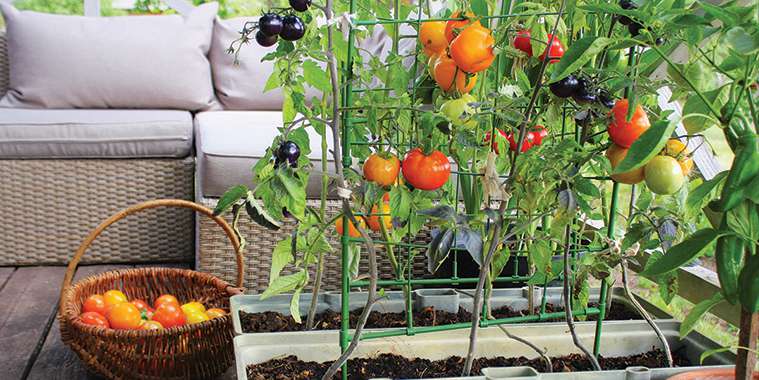Growing your own food is one of summer’s highlights. But if you live in an apartment or a condo — or just have a tiny yard — you may think this simple pleasure is out of reach. That’s where small-space and vertical gardening comes in.
The beauty of such a garden is that it can be located almost anywhere and allows you to skip most soil-borne diseases since you’re creating the ideal growing environment in a pot. This type of garden also puts your harvest within easy reach, skipping a trip to the grocery store. To give your container garden a strong start, skip the seeds and plant vigorous young vegetable plants from any garden centre.
With a little planning and imagination, and a decent amount of direct sunlight, vegetable gardens can be grown anywhere, regardless of how small your space is.
The basics
The first step is to determine what the conditions are like in the area you’re going to put your garden. The amount of sunlight will be the greatest factor in determining which plants will thrive in your urban environment.
If your balcony or patio is shaded by tall buildings most of the time, you should choose your plants accordingly. Leafy vegetables like lettuce, cabbage and other greens do well with limited sunlight, making good choices for shady areas. If you’re blessed with lots of sunshine, you have more plants to choose from such as tomatoes, peppers, potatoes, beans, carrots and radishes Even vine crops, such as squash, pumpkins and cucumbers can be grown as long as the container is deep enough to accommodate them and proper staking is available. Also, compact bush plants specifically created for container planting have become easier to find at your local greenhouse.
To grow a successful container vegetable garden, start with great soil known as potting mix. These mixes contain the right blend of materials like coir, peat moss and compost to create an ideal growing environment for roots inside a pot. Potting mixes don’t compact, but instead provide good drainage and air flow. Another great option is a moisture control potting mix, which helps protect plants against over- and under-watering. These soils can be purchased in small to large bags at almost all stores, and are easily and neatly transported, particularly if you have to get them up to your suite in an elevator.
Growing vegetables in pots allows you to massage the growing season by placing pots in an area with a micro-climate. For instance, lining pots along a south-facing wall in early spring warms soil quickly so you can plant sooner. In autumn, a south- or west-facing wall retains heat and can help extend the growing season as frost threatens.
Pots dry out much faster than in-ground gardens, which is why container gardening success hinges largely on watering. As vegetables grow and roots fill the soil, plants need more water to stay healthy and yield a harvest. You’ll want to check soil daily, and water whenever the top inch becomes dry. Another option is to install a drip irrigation system (sold in simple-to-assemble kits online and at home improvement stores) that will do the watering work for you.
And don’t forget to feed your plants! In fact, plant food works in tandem with great soil to provide your veggies with just the right amount and type of nutrition throughout the growing season. About a month after planting, begin feeding regularly to ensure a good harvest.
Decide on a method
Almost any vegetable that can be grown in a garden will also work well as a container-grown plant. Nearly any type of container can be used for growing vegetable plants. Old washtubs, wooden crates, large coffee cans, and even buckets can be used for growing crops as long as they provide adequate drainage.
• Shelves Since most vegetables can be easily grown in containers, shelves offer the benefit of growing many types of vegetables on each shelf as high up as you can reach. Containers can also be situated on tiers if you don’t have shelves.
• Hanging baskets Hanging baskets can be placed on the balcony or on suitable hangers. Not only do peppers and cherry tomatoes look good in hanging baskets, so do trailing plants like the sweet potato vin. They also thrive nicely in them. You can also buy long planters that sit horizontally directly on your balcony railing, as well as planter boxes on legs, both of which are great if you have bad knees!
• Trellises Trellises can be used for the support of trailing or vine crops. A fence or railing can also serve as a trellis for beans, peas, tomatoes and vine crops like squash and cucumbers. Use a stepladder as a makeshift trellis to support vine-growing plants. The rungs of the ladder can be used to train the vines while placing the vegetables on its steps for further support.
• Pre-made vertical systems There are many types of affordable, pre-made planting systems as well, from simple pocket-style pre-planted bags to more complex trickle-down plastic wall-mounted modular screens. Check out your local gardening centre for options, or online.
Be creative and find something that works for you and your unique situation. Growing a vertical vegetable garden is the perfect way for you to enjoy a bountiful harvest of freshly grown vegetables without taking up already limited space.



